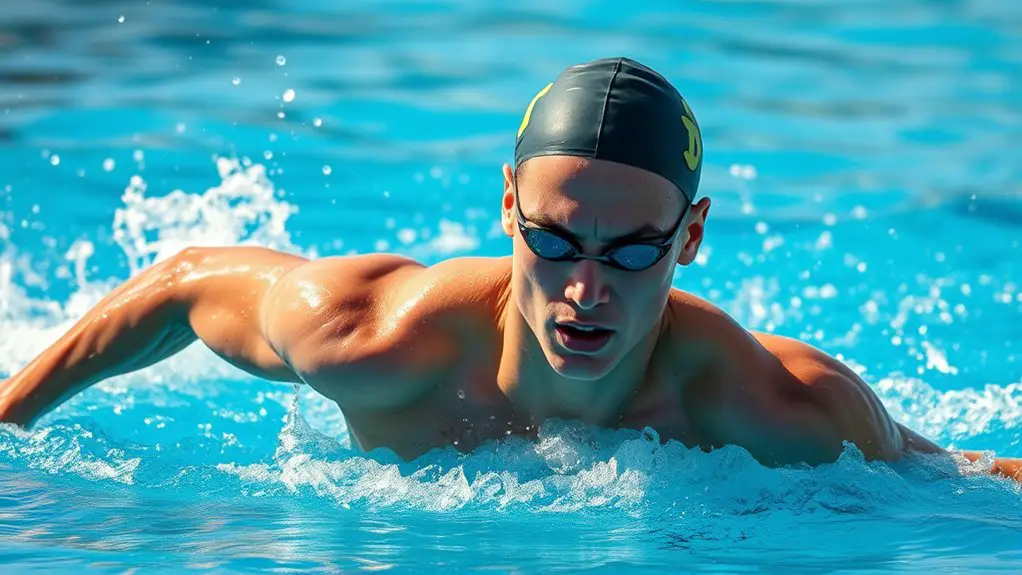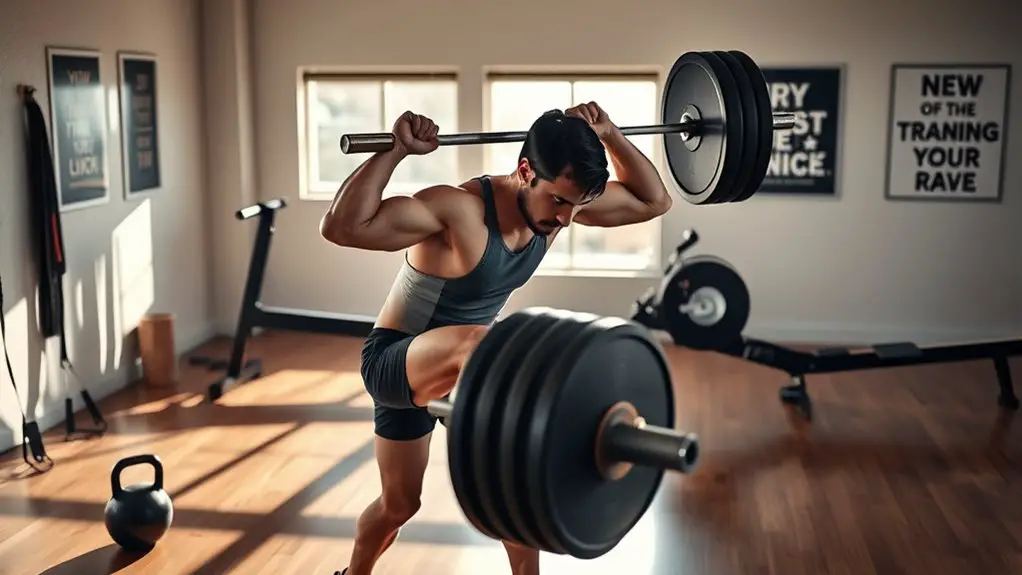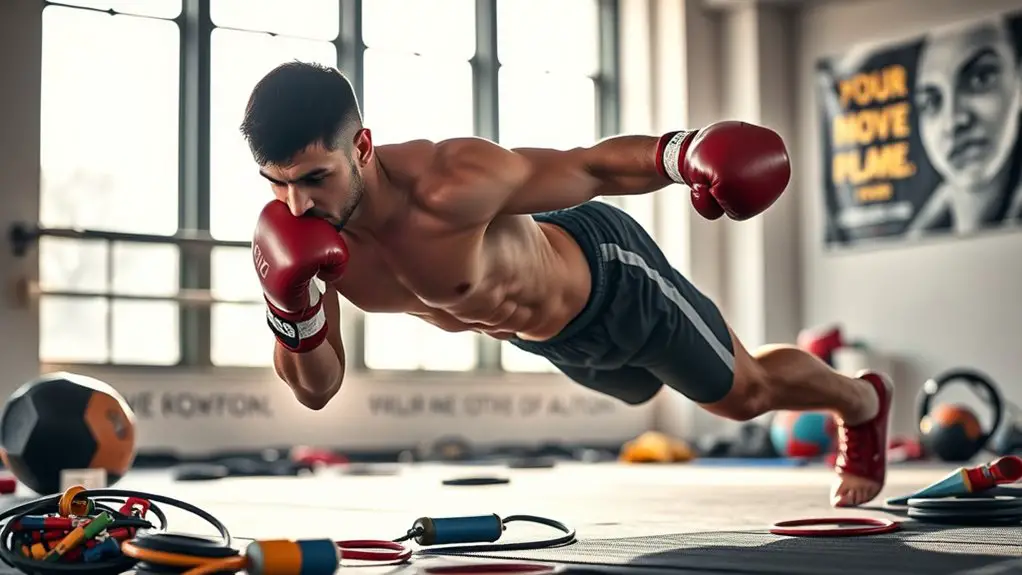Core strength is essential for improving your stroke rate in swimming. A strong core stabilizes your body, allowing efficient energy transfer during strokes. This stability helps maintain proper posture, reducing fatigue and enhancing stroke power. When your core is engaged, you'll experience smoother and more efficient movements in the water. By focusing on core strength, you can maximize your performance and endurance. If you want to discover effective exercises and strategies, continue exploring this topic further.
Understanding Core Strength and Its Importance in Swimming
While many swimmers focus on their arms and legs, understanding core strength is essential for enhancing your overall performance in the water. Your core acts as a bridge between your upper and lower body, providing the core stability needed to streamline your movements. When you engage your core muscles, you're not just improving your posture; you're creating a powerful foundation for every stroke you take.
A strong core allows for better muscle engagement, directly impacting your stroke rate. By stabilizing your body, you can transfer energy more efficiently from your arms and legs, leading to smoother, more powerful strokes. This means less effort and more freedom to glide through the water. Additionally, developing core strength helps prevent injuries by stabilizing the spine and pelvis, allowing for unrestricted physical pursuits.
The Anatomy of Core Muscles in Athletes
The core muscles in athletes form a complex network that goes beyond just the abs. This core muscle anatomy includes the rectus abdominis, obliques, transverse abdominis, and muscles in your lower back and pelvis. Together, they stabilize your body during movement, providing a solid foundation for power and agility. You might not realize it, but each twist, turn, and lunge relies on these muscles working in harmony.
Understanding core muscle functions is essential for enhancing your athletic performance. They not only support your spine but also assist in transferring energy efficiently from your limbs to the center of your body. When you engage these muscles properly, you can achieve greater control and flexibility, allowing for more fluid movements. By honing your core strength, you're not just building a six-pack; you're revealing your body's full potential, giving you the freedom to move as you desire. Additionally, incorporating exercises like squats and deadlifts can further strengthen your core, enhancing overall athletic performance.
How Core Strength Affects Stroke Rate
Core strength plays an essential role in determining your stroke rate, as it directly influences your ability to generate power and maintain stability during each movement. When you have strong core stability, you're able to transfer energy more efficiently from your lower body through your core to your arms, enhancing your overall stroke mechanics. This means you can move fluidly, keeping your momentum flowing without unnecessary disruptions.
If your core is weak, you might find yourself compensating with other muscle groups, leading to inefficient strokes and a decreased stroke rate. A robust core allows you to maintain proper posture and alignment, which is vital for executing powerful strokes while minimizing fatigue. So, when you prioritize core strength, not only do you improve your stroke rate, but you also enjoy a more liberated and dynamic experience in the water. Embrace the freedom that comes with a strong core, and watch your performance soar. Additionally, incorporating mobility training into your routine can further enhance your core strength and overall athletic performance.
The Connection Between Stability and Stroke Efficiency
When your body maintains stability throughout each stroke, you're able to swim more efficiently and effectively. Core stability plays a vital role in optimizing stroke mechanics, reducing drag, and enhancing your overall performance in the water. With a strong core, you can keep your body aligned, allowing for smoother and more controlled movements. Additionally, incorporating mobility work into your training can further improve joint function and enhance your overall efficiency in the water.
| Aspect | Impact on Stroke Efficiency |
|---|---|
| Core Stability | Reduces body rotation, enhancing streamline |
| Alignment | Improves power transfer through each stroke |
| Balance | Minimizes energy waste, promoting endurance |
Exercises to Build Core Strength for Swimmers
To enhance your swimming performance, incorporating specific exercises that target core strength is essential. Start with stability exercises like planks and side planks, which help you maintain balance and control in the water. These exercises engage your abdominals and lower back, creating a solid foundation for your strokes.
Next, consider resistance training to further build strength. Exercises like medicine ball twists or cable rotations can enhance your core's rotational power, vital for a powerful stroke. You can even use resistance bands for added challenge.
Another effective move is the bird-dog, which promotes stability while engaging multiple core muscles. Additionally, strengthening your core can lead to better balance and coordination, which is crucial for executing efficient swimming strokes.
Integrating Core Training Into Swim Workouts
To enhance your swimming performance, it's essential to integrate core training into your workouts. You can focus on specific core exercises, timing, and technique during practice, making it a seamless part of your routine. Additionally, incorporating targeted drills will help reinforce the connection between core strength and your stroke rate. This approach not only improves your overall strength but also enhances your coordination and stability in the water.
Core Exercises for Swimmers
Although many swimmers focus primarily on stroke technique and endurance, integrating core exercises into swim workouts can greatly enhance performance. Building core stability allows you to maintain better body alignment in the water, ultimately leading to more efficient strokes. Simple exercises like planks, Russian twists, and medicine ball throws can be incorporated into your routine without taking much time. You might even find joy in adding these to your warm-up or cooldown. As you strengthen your core, you'll notice improvements in your overall swim performance, giving you the freedom to glide through the water with ease. So, don't underestimate the power of a strong core—embrace these exercises and watch your swimming transform!
Timing and Technique Focus
Integrating core training into your swim workouts isn't just about adding exercises; it's about timing and technique. By focusing on timing drills, you'll enhance your rhythm in the water, allowing for more fluid strokes. Core strength supports this by stabilizing your body, which is essential for maintaining proper alignment.
As you refine your technique, pay attention to how your core engages during each stroke. This connection empowers you to execute more efficient movements, reducing drag and increasing your stroke rate. Remember, it's not just about power; it's about the precision that comes from a strong core. Embrace this approach, and you'll find a newfound freedom in your swimming, as well as noticeable improvements in your performance.
Incorporating Drills in Practice
While you might think of core training as separate from your swim practice, incorporating specific drills can seamlessly enhance your performance in the water. Integrating drill variations into your workouts not only builds core strength but also improves your overall stroke rate. Try adding resistance bands during freestyle drills or engage in flutter kicks while holding onto the pool wall. These exercises increase practice intensity and help you maintain proper form. As you play with different drill variations, pay attention to how your body responds; this freedom allows you to discover what works best for you. So, don't shy away from mixing core-focused drills into your routine—your swim performance will thank you!
Monitoring Progress: Assessing Core Strength Improvements
As you commence your journey to enhance core strength, monitoring your progress becomes essential for ensuring that your efforts are effective. Conducting regular core assessments and strength measurements allows you to pinpoint areas of improvement and stay motivated.
Here's a simple table to track your progress:
| Date | Exercise | Core Strength Level |
|---|---|---|
| Week 1 | Plank (30 seconds) | Beginner |
| Week 4 | Plank (1 minute) | Intermediate |
| Week 8 | Plank (2 minutes) | Advanced |
Real-Life Examples: Athletes Who Benefited From Core Training
Many athletes have experienced significant performance gains after incorporating core training into their routines. This isn't just a trend; it's an essential part of many elite swimmers' training regimes. By enhancing their core strength, they've revealed new levels of efficiency and power in their strokes.
Here are four inspiring examples of athlete success through core workouts:
- Michael Phelps: Known for his impressive core workouts, Phelps has transformed his stroke rate, making him one of the fastest swimmers ever.
- Katie Ledecky: She attributes her endurance and speed to a strong core, allowing her to maintain a powerful stroke over long distances.
- Ryan Lochte: His diverse core training has contributed to his versatility and strength in the pool.
- Missy Franklin: Core workouts have helped her improve her balance and streamline her strokes, leading to record-breaking performances.
It's clear: core strength is a game-changer for athletes, as it enhances balance for fluid movement and contributes to overall performance.
Frequently Asked Questions
How Does Core Strength Impact Breathing Technique in Swimming?
Imagine swimming like a fish, yet gasping for air – not exactly the freedom you're after, right? Core strength is your secret weapon for perfecting breathing coordination. It stabilizes your body in the water, allowing you to breathe more efficiently without disrupting your stroke. When you're stable, you're free to focus on your rhythm, ensuring every breath you take propels you forward, rather than holding you back. Embrace your core, and swim with confidence!
Can Core Strength Training Help Prevent Swimming-Related Injuries?
Yes, core strength training can definitely help prevent swimming-related injuries. When you focus on core stability, you're building a strong foundation that supports your body during every stroke. This not only enhances your performance but also reduces the risk of overuse injuries. By engaging your core, you maintain better alignment and balance in the water, allowing you to swim freely and enjoyably, without the constant worry of injuries holding you back.
What Age Is Appropriate to Start Core Training for Swimmers?
When it comes to youth training, starting core training can be beneficial as early as age 7 or 8, depending on the child's physical development. Age guidelines suggest focusing on bodyweight exercises to build a foundation rather than heavy lifting. By introducing core training at a young age, you're not only enhancing their swimming performance but also promoting overall strength, stability, and injury prevention. Embrace the journey and let them enjoy the process!
Are There Specific Diets That Enhance Core Strength Development?
Sure, you could just eat pizza and hope for the best, but if you really want to enhance your core strength, focusing on nutrient density is key. Timing your protein intake around workouts can also make a difference. Instead of waiting for that perfect moment to indulge, consider how lean meats, legumes, and leafy greens can fuel your training. You'll feel stronger and more capable, all while enjoying the freedom of delicious, nourishing food.
How Often Should Swimmers Train Their Core for Optimal Performance?
For ideal performance, you should aim for core training frequency of two to three times a week. Each session can be 20 to 30 minutes long, focusing on various exercises that engage all muscle groups. This way, you're not overloading your body but still getting effective workouts. Remember, consistency is key, so find a routine that fits your lifestyle and keeps you feeling free and energized in the water!




